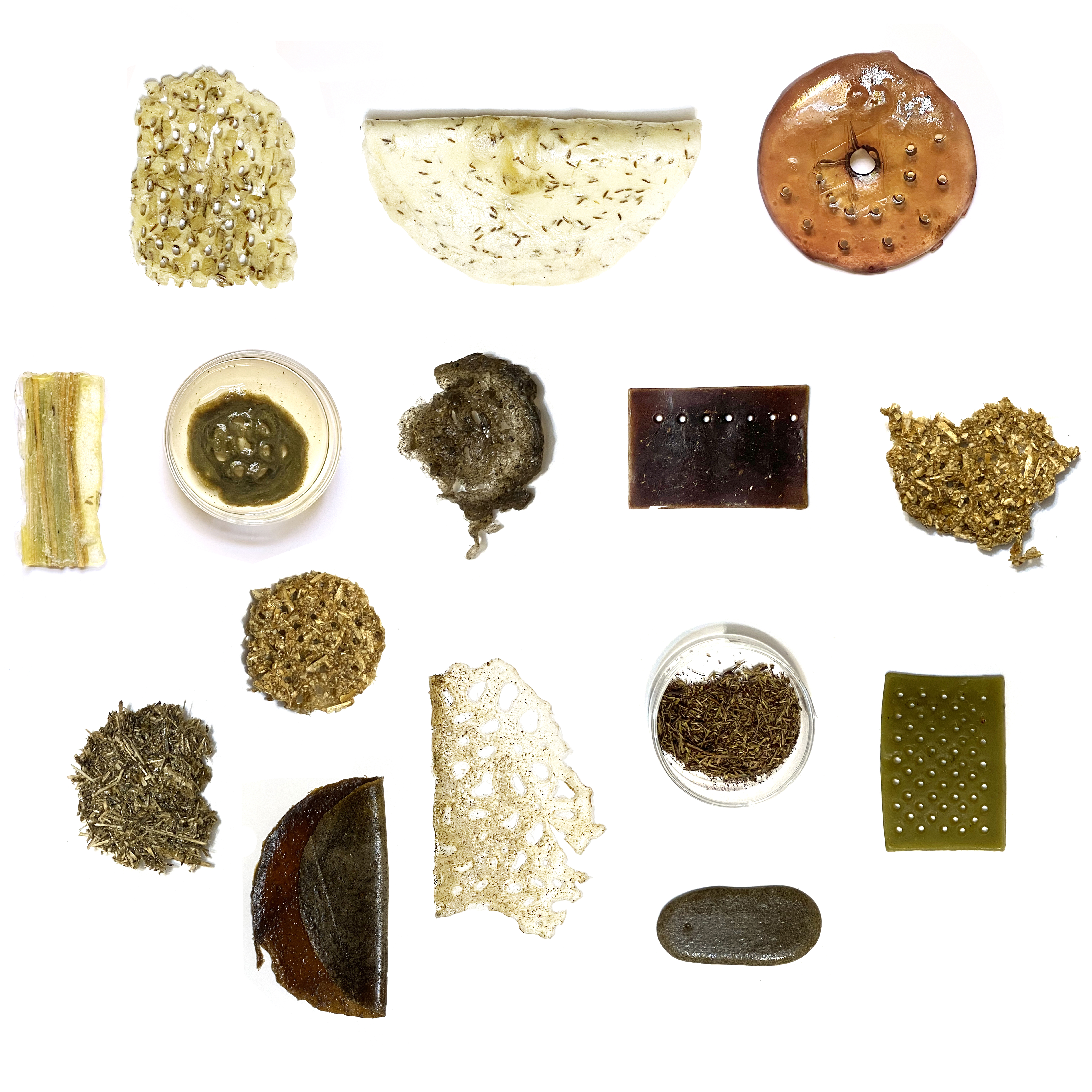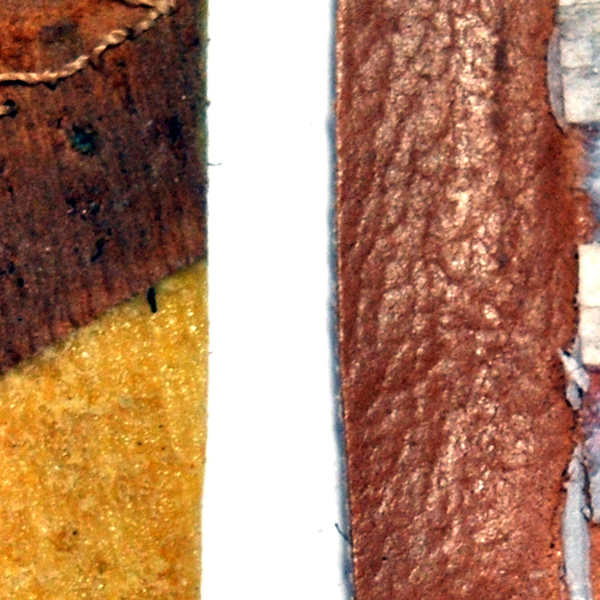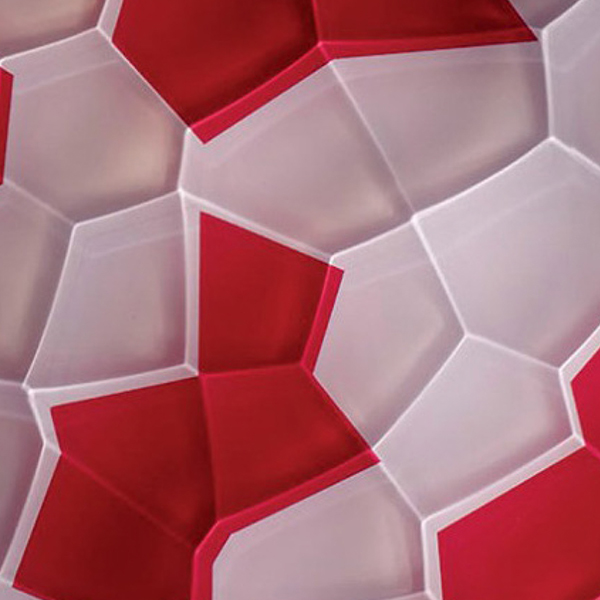
Ruderal Material Project
Presented at Cumulus 2022, exerpt from full paperBelle Isle Wet-Mesic Flatwoods, Detroit, MI
What do the creeping thistle (Cirsium arvense), curly dock (Rumex crispus), and American pokeweed (Phytolacca americana) have in common?
They are all ruderal plants1 found thriving within North American urban ecological wastelands2. This community of wild, pioneering plants — a mix of native and invasive species — are the first to lay root to land that has been laid to waste by natural or man-made destruction.
Ruderal plants are the changemakers: adapting, surviving, and growing in the most barren of soils within our cities.
This project highlights the material taxonomies of ruderal flora colonizing Detroit’s historic Belle Isle’s wet-mesic flatwoods3 — home to some of Michigan’s most endangered plant species — currently disrupted by flooding, human disturbance, deforestation, and pollution.
The project explores how these disturbance-adaptive species indicate revelations of a future material landscape4 through a series of sourced, processed, and made material samples, intended to expand critical awareness of the human and environmental effects of climate change.
__________
1 A ruderal species is a plant species that is first to inhabit disturbed lands.
2 Wastelands describe areas disrupted by natural disasters (flooding, wildfire, avalanches, etc.) or a result of human activity (construction, roads, mining, fire, agriculture, etc.).
3 Wet mesic flatwoods are moist forests – fluctuating between levels of wet and dry – creating a unique habitat for adaptable flora and fauna.
4 A material landscape, in this scenario, is a physical representation of material samples that identify potential opportunities for future applications

Background
The Wet-Mesic Flatwoods is a unique ecosystem on the eastern side of Detroit’s third largest island, Belle Isle, “a swampy type of forest that the Michigan Natural Features Inventory lists as ‘imperiled’ in Michigan.” (Allnutt, 2020) The Flatwoods, as they are commonly referred, are the home to several colonies of native trees, including pumpkin ash (Fraxinus profunda), red mulberry (Morus rubra) and Shumard oak (Quercus shumardii), all currently on the Michigan Natural Features Inventory (MNFI) threatened species list, the last of special concern (Slaughter, B. & Cohen, J. & Kost, M., 2010). Beneath their canopies lie a low-growing range of flora — a mix of species identified as native and non-native species, the latter having the potential to be considered invasive if their growth causes harm to humans, the economy, or the environment. Due to natural and man-made disturbances — including flooding, human excavation, fires, and pollution — many native communities of plants have been removed or displaced, only to be replaced by the more adaptive colonies of ruderal plants.
Patches of native soil are still viable to provide support to the vestiges of a native ecosystem through dormant seed banks, but in the case of Belle Isle, large areas of non-native soil have been brought in as fill. The idea that communities can be restored to their original ecosystems by removing ruderal colonization and reseeding with native plants is an overly simplistic view (Del Tridici, 2014) in the wake of climate change — with rising waters, warmer temperatures, and the continued human intervention to restore the environment to what it once was. Notable French biologist, Antoine Laurent de Lavosier stated, “In nature, nothing is created and nothing is destroyed, but everything is transformed.” If disturbance is a part of nature, learning to adapt is the best way forward.
The The Wet-mesic Flatwoods is cartographically divided into eight cells outlined by a series of winding “roads and trails that play a significant role in shaping the current characteristic of the flatwoods.” (Slaughter, B. & Cohen, J. & Kost, M., 2010). This mapping strategy presented eight contact points of discovery. Within each cell, a site was selected to represent the cell based on 1) observed natural or human disturbance to the land; and 2) the diversity of flora within the perimeters. A one-foot square snapshot of the micro-environment was photodocumented and each plant was identified.

Adaptive Design Practices Through Ruderal Thinking
Ruderal plants thrive in anthropogenic habitats, pushing up through wastelands to colonize disordered communities, rising as the harbingers of changing ecosystems. And yet, as Susan Cowles states in her dissertation, Brooklyn Says, “Move to Detroit”: Ruderal Aesthetics, ruderals are “metaphorically paradoxical: indexing catastrophe and abandonment, yet conversely representing resilience and renewal.” (2017). In addition to Cowles, some noteworthy art and design examples of current ruderal thinking are Ben Hartley’s Ruderal, where he “explores the parallels between Ruderal plant species with the processes of gentrification and urban renewal.” (Hartley, 2020); Ruderal Consciousness, a collection of works by artist Sam Schmitt at Hartslane Gallery, London, including an installation “encouraging plants to sprout in unexpected places” (Akriditis, 2020); and Margaret Haugwort’s and Oliver Kellhammer’s, Ruderal Witchcraft (Haugwort and Kellhammer, 2021), a project that considers a “set of practices specific to planetary, weedy natures that work their way at edges and interstices of public and private property, and which are entangled with a range of other human and non-human outcasts of capitalist modernity.” Designers and artists pursuing ruderal thinking in original design outcomes require the creation of these new principles that exhausts all assumptions, whereby all solutions are measured. As a designer with a specific focus on natural and waste materials with a sense of place, “new materials can offer new, unique combinations of properties which enable original design,” (Ashby, p. 5) yet initiating small modifications, shifts, and changes is the approach to considering larger adaptive material systems.
Collecting Kin-Like Materials
Early in the research phase, the decision was made not to interfere with the ecosystem on Belle Isle when procuring plant matter for material experimentation. Therefore, the search for material “kin” to those found within the Belle Isle Wet-mesic Flatwoods cells led to meanderings through industrial parks, empty lots, neighborhood sidewalks, and ditches within Detroit neighborhoods. This process of plant collection presented its own unique rewards and challenges. This secondary layer of discovery added a deeper understanding of the plants through recognition of taxonomy, environment, and communities. Some species identified on Belle Isle were elusive to secondary discovery and therefore were omitted from some of the final material landscapes. This “extinction” of the plant material could be considered a metaphor for future access to natural resources.


Making Material Samples: Aerate, Perforate, and Disperse
The taxonomy of the plants was classified through a digital dichotomous key — a combination of digital apps to identify, cross-reference, and archive each plant species, which included PictureThis, PlantNet, and Seek by iNaturalist. While every attempt was made to properly identify the species, this is an exercise in curiosity and investigation and is not intended to reflect the rigorous standards of scientific botany. Each snapshot was used as a framework for conceptualizing the form, substances, color, and texture of the materials. Additionally, each material sample aims to address the strengths and weaknesses of the original material to provoke an adaptive outcome.
A common narrative arose representing a shared attribute among the ruderal species, being the ability to thrive in compacted, low-oxygen soil. Heavy machinery used for building and paving leads to compacted ground; and additional flooding caused by climate change and human intervention can produce further oxygen deprivation in soils. Many plants have the ability to adapt to low soil oxygen by changing their root anatomy and architecture in a process called aerenchyma (Yamauchi, 2021). The final samples were based on adapting to changing environments through perforation (inspired by oxygen-deprived soil), foamed sponges for hydrophobic aeration, hydro-gels for protective biological coatings, and waxes for heattriggered, form-shifting materials. This process of creating space — or pockets of air — was applied to all samples within the material landscapes.
All materials originated from the core recipes of the Bioplastic Cookbook (2018) with iterations and adaptations. Biodesign, as a design discipline, is “a way to provoke debate and explore the potential opportunities and dangers of manipulating life for human purposes.” (Myers, 2013) Several methods were used to process the materials, including drying, shredding, and grinding to make pastes, powdered pigments, and shavings to disperse the matter within the bio-composites. The material samples are completely bio-based; therefore, the landscapes will change over time, eventually shifting and decomposing.
The material samples and final material landscapes are abstract concepts for potential future artifacts and surfaces. They are considerations for opportunities and innovations for material adaptations. Of the eight cells, three were selected to create final landscapes, Cell 3, Cell 5, and Cell 7. Multiple experiments were executed to iterate a body of samples for consideration for each cell, seen collectively in the final collaborative landscape.

(Image: Monocot Root Acorus, Wikimedia Commons)

Example of Material Landscape: Cell 5
Cell 5 is located south of Central Avenue, where the soil has been disturbed by an unpaved road leading south toward Shadownook Street. The site selected (42.343686, 82.974061) for the material snapshot included American burnweed (Erechtites hieraciifolius), lady's thumb (Persicaria maculosa), yellow rocket (Barbarea vulgaris), lambsquarter (Chenopodium album), reed canary grass (Phalaris arundinacea), and creeping thistle (Cirsium arvens). The final material landscape includes 1) a hydrogel, intended to protect and hydrate, with embedded powdered pigments including a) American burnweed (Erechtites hieraciifolius), dehydrated and powdered, b) yellow rocket (Barbarea vulgaris) flowers, dehydrated and powdered, b) lady's thumb (Persicaria maculosa); 2) a perforated bio-textile, which dehydrates and re-hydrates to promote aeration, consisting of c) lambsquarter (Chenopodium album) hangdried and powdered, water, glycerin, and carrageenan; and 3) a brittle sponge made of shredded e) reed canary grass (Phalaris arundinacea), water, and carrageenan.
Conclusion
The Ruderal Material Project was initiated to bring awareness to the unique ecosystem that is the Wet-mesic Flatwoods through observing the attributes and relationships of adaptive ruderal plant species. The intent was not to create singular solutions, but to conceptualize potential ways of thinking and designing that could be applied to new artifacts, systems, and environments. Consideration of these material samples begins as starting points for adaptive future materials, ones that might require you to remain hydrated to fit, spend time in nature to shift color, or provide aeration where space is needed to breathe.
This project is an invitation to look at disturbance, wastelands, and weeds as indicators of change, considering these changes as potential for adaption and innovation. Change does not require complete destruction, as disturbance is an essential part of the working order of nature. Working incrementally forward, adapting through small shifts, and moving through extinction into the direction of renewal.
__________
References
(Full Paper)Akritidis, N. (2020). Ruderal Consciousness. SWMS. https://www.samschmitt.org/ruderal-consciousness.html
Allnutt, B. (2020, September 29). How has flooding impacted Belle Isle’s ‘imperiled’ Wet-Mesic Flatwoods forest?Planet Detroit. https://planetdetroit.org/2020/08/did-belle-isles-flood-impact-the-islands-imperiled-wetmesic-flatwoods-forest/
Antonelli, P., & Myers, W. (2018). Bio Design: Nature + Science + Creativity (Expanded, Revised ed.). The Museum of Modern Art, New York.
Ashby, M. F. (1992). Materials Selection in Mechanical Design. Butterworth-Heinemann.
Bioplastic Cook Book | FabTextiles. (2018, September 13). Web: www.fabtextiles.org. http://fabtextiles.org/bioplastic-cook-book/
Bostick, J. (2021, March 23). Belle Isle’s Unique Ecosystem Faces a Changing Climate. Detroit Is It. https://detroitisit.com/belle-isle-and-the-threat-of-a-changing-climate/
Botkin, D. (1990) Discordant Harmonies: A New Ecology for the Twenty-first Century, New York: Oxford University Press.
Buscher, B., & Fletcher, R. (2020). The Conservation Revolution: Radical Ideas for Saving Nature Beyond the Anthropocene [E-book]. Verso.
Carlson, A. (2000). Aesthetics and the Environment: The Appreciation of Nature, Art, and Architecture, London: Routledge.
Cowles, S. (2017). Brooklyn Says, “Move to Detroit”: Ruderal Aesthetics. School of Architecture. University California.
Peter Del Tredici, The Flora of the Future, Places Journal, April 2014.
Elliot, P., Hare, B., & Wilson, A. (2003). Boyle Family (1st ed.). Natl Galleries of Scotland.
Franklin, K. & Till, C. (2020). Radical Matter: Rethinking Materials for a Sustainable Future, Thames & Hudson.
Hartig, T. & Evans, GW & Jamner, LD & Davis, D.S. & Gärling, T. (2003). Tracking restoration in natural and urban field settings. J Environ Psychology 23:109–123.
Hartley, B. (2020). Episode 4: Ruderal, Bricks St. Annes House Public Art in Bristol. [Video]. You Tube. https://www.bricksbristol.org/2020/12/episode-4-ben-hartley-ruderal
Kerns, B., Guo, Q. (2012). Climate Change and Invasive Plants in Forests and Rangelands. U.S. Department of Agriculture, Forest Service, Climate Change Resource Center. https://www.fs.usda.gov/ccrc/topics/invasive-plants
Huaghwout, Margaretha. (2021). Margaretha Haughwout at Ruderal Ecologies II “Ruderal Witchcraft.” (2021, October 28). [Video]. YouTube. https://www.youtube.com/watch?v=5OEocKuqZlA
Potts, R. & Simms, A. (2012). New Materialism: How Our Relationship with the Material World Can Change for The Better. Schumacher College, England: Bread Print and Roses.
Slaughter, B. & Cohen, J. & Kost, M. (2010). Natural Community Abstract for Wet-mesic Flatwoods.10.13140/RG.2.1.1390.2886.
Sweetser, R. What Weeds Tell You About Your Soil. (2021, November 24). Almanac. https://www.almanac.com/what-weeds-tell-you-about-your-soil
Wilton, H.D. Enander, and K.M. Korroch. (2020). Michigan Natural Community Classification.Michigan Natural Features Inventory, Michigan State University Extension, Lansing, Michigan.
Yamauchi T. (2021). Climate-smart crops: key root anatomical traits that confer flooding tolerance. 2021 by JAPANESE SOCIETY OF BREEDING.
https://www.jstage.jst.go.jp/article/jsbbs/71/1/71_20119/_article/-char/ja
Yelavich, S & Adams, B. (2014). Design as Future Making, ed., 198-214. London: New York: Bloomsbury Publishing.









